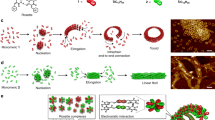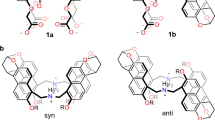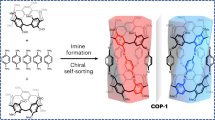Abstract
Macrocyclic compounds show highly symmetric structures, making them useful building blocks for the creation of various supramolecular assemblies. The properties of such supramolecular assemblies result from their shape, functionality, and structure. In 2008, we reported a new type of polygonal-shaped macrocycle termed “pillar[n]arenes”. In this Focus Review, based on their polygonal structures, versatile functionality, and host–guest behavior, I present various pillar[n]arene-based supramolecular assemblies that have been investigated over the last 10 years in our group. Based on the versatile functionalization of pillar[n]arenes, continuous and length-controllable discrete one-dimensional channels, two-dimensional sheets, and three-dimensional vesicles have been produced. Bulk-state complexations using liquid and crystalline pillar[n]arenes are also discussed. The functionalization of pillar[n]arenes is also useful for creating functionalized crystals, and such crystals have shown guest-responsive changes in color, state, and water contact angle, as well as serving as reaction media for the spontaneous polymerization of cyclic monomers.
This is a preview of subscription content, access via your institution
Access options
Subscribe to this journal
Receive 12 print issues and online access
$259.00 per year
only $21.58 per issue
Buy this article
- Purchase on Springer Link
- Instant access to full article PDF
Prices may be subject to local taxes which are calculated during checkout















Similar content being viewed by others
References
Harada A, Hashidzume A, Yamaguchi H, Takashima Y. Polymeric rotaxanes. Chem Rev. 2009;109:5974–6023.
Engeldinger E, Armspach D, Matt D. Capped cyclodextrins. Chem Rev. 2003;103:4147–74.
Crini G. Review: a history of cyclodextrins. Chem Rev. 2014;114:10940–75.
Wenz G, Han B-H, Müller A. Cyclodextrin rotaxanes and polyrotaxanes. Chem Rev. 2006;106:782–817.
Rekharsky MV, Inoue Y. Complexation thermodynamics of cyclodextrins. Chem Rev. 1998;98:1875–918.
Pedersen CJ. Cyclic polyethers and their complexes with metal salts. J Am Chem Soc. 1967;89:7017–36.
Zheng B, Wang F, Dong S, Huang F. Supramolecular polymers constructed by crown ether-based molecular recognition. Chem Soc Rev. 2012;41:1621–36.
Morohashi N, Narumi F, Iki N, Hattori T, Miyano S. Thiacalixarenes. Chem Rev. 2006;106:5291–316.
Gutsche CD. Calixarenes. Cambridge: The Royal Society of Chemistry; 1989.
Ikeda A, Shinkai S. Novel cavity design using calix[n]arene skeletons: toward molecular recognition and metal binding. Chem Rev. 1997;97:1713–34.
Homden DM, Redshaw C. The use of calixarenes in metal-based catalysis. Chem Rev. 2008;108:5086–130.
Freeman WA, Mock WL, Shih NY. Cucurbituril. J Am Chem Soc. 1981;103:7367–8.
Kim J, Jung I-S, Kim S-Y, Lee E, Kang J-K, Sakamoto S, et al. New cucurbituril homologues: syntheses, isolation, characterization, and X-ray crystal structures of cucurbit[n]uril (n = 5, 7, and 8). J Am Chem Soc. 2000;122:540–1.
Lee JW, Samal S, Selvapalam N, Kim H-J, Kim K. Cucurbituril homologues and derivatives: new opportunities in supramolecular chemistry. Acc Chem Res. 2003;36:621–30.
Lagona J, Mukhopadhyay P, Chakrabarti S, Isaacs L. The cucurbit[n]uril family. Angew Chem Int Ed. 2005;44:4844–70.
Liu Z, Nalluri SKM, Stoddart JF. Surveying macrocyclic chemistry: from flexible crown ethers to rigid cyclophanes. Chem Soc Rev. 2017;46:2459–78.
Laughrey Z, Gibb BC. Water-soluble, self-assembling container molecules: an update. Chem Soc Rev. 2011;40:363–86.
Murray J, Kim K, Ogoshi T, Yao W, Gibb BC. The aqueous supramolecular chemistry of cucurbit[n]urils, pillar[n]arenes and deep-cavity cavitands. Chem Soc Rev. 2017;46:2479–96.
Okumura Y, Ito K. The polyrotaxane gel: a topological gel by figure-of-eight cross-links. Adv Mater. 2001;13:485–7.
Ogoshi T, Kanai S, Fujinami S, Yamagishi TA, Nakamoto Y. para-bridged symmetrical pillar[5]arenes: Their Lewis acid catalyzed synthesis and host-guest property. J Am Chem Soc. 2008;130:5022–3.
Ogoshi T, Yamagishi TA, Nakamoto Y. Pillar-shaped macrocyclic hosts pillar[n]arenes: new key players for supramolecular chemistry. Chem Rev. 2016;116:7937–8002.
Ogoshi T, Aoki T, Kitajima K, Fujinami S, Yamagishi T, Nakamoto Y. Facile, rapid, and high-yield synthesis of pillar[5]arene from commercially available reagents and Its X-ray crystal structure. J Org Chem. 2011;76:328–31.
Wilson CR, Chen EFW, Puckett AO, Hof F. Ethoxypillar[6]arene. Org Synth. 2022;99:125–38.
Fa S, Kakuta T, Yamagishi T-A, Ogoshi T. Conformation and planar chirality of pillar[n]arenes. Chem Lett. 2019;48:1278–87.
Ogoshi T, Masaki K, Shiga R, Kitajima K, Yamagishi TA. Planar-chiral macrocyclic host pillar[5]arene: no rotation of units and isolation of enantiomers by introducing bulky substituents. Org Lett. 2011;13:1264–6.
Ogoshi T, Yamafuji D, Aoki T, Kitajima K, Yamagishi T, Hayashi Y, et al. High-yield diastereoselective synthesis of planar chiral [2]- and [3]rotaxanes constructed from per-ethylated pillar[5]arene and pyridinium derivatives. Chem Eur J. 2012;18:7493–500.
Li C. Pillararene-based supramolecular polymers: from molecular recognition to polymeric aggregates. Chem Commun. 2014;50:12420–33.
Wang Y, Ping G, Li C. Efficient complexation between pillar[5]arenes and neutral guests: from host-guest chemistry to functional materials. Chem Commun. 2016;52:9858–72.
Shu X, Chen S, Li J, Chen Z, Weng L, Jia X, et al. Highly effective binding of neutral dinitriles by simple pillar[5]arenes. Chem Commun. 2012;48:296–9.
Li C, Han K, Li J, Zhang Y, Chen W, Yu Y, et al. Supramolecular polymers based on efficient pillar[5]arene—neutral guest motifs. Chem Eur J. 2013;19:1189–7.
Strutt NL, Zhang HC, Schneebeli ST, Stoddart JF. Functionalizing pillar[n]arenes. Acc Chem Res. 2014;47:2631–42.
Strutt NL, Forgan RS, Spruell JM, Botros YY, Stoddart JF. Monofunctionalized pillar[5]arene as a host for alkanediamines. J Am Chem Soc. 2011;133:5668–71.
Zhang ZB, Xia BY, Han CY, Yu YH, Huang FH. Syntheses of copillar[5]arenes by co-oligomerization of different monomers. Org Lett. 2010;12:3285–7.
Ogoshi T, Hashizume M, Yamagishi TA, Nakamoto Y. Synthesis, conformational and host-guest properties of water-soluble pillar[5]arene. Chem Commun. 2010;46:3708–10.
Guo M, Wang X, Zhan C, Demay-Drouhard P, Li W, Du K, et al. Rim-differentiated C5-symmetric tiara-pillar[5]arenes. J Am Chem Soc. 2018;140:74–7.
Hu X-B, Chen Z, Chen L, Zhang L, Hou J-L, Li Z-T. Pillar[n]arenes (n = 8–10) with two cavities: synthesis, structures and complexing properties. Chem Commun. 2012;48:10999–1001.
Ogoshi T, Demachi K, Kitajima K, Yamagishi T. Monofunctionalized pillar[5]arenes: synthesis and supramolecular structure. Chem Commun. 2011;47:7164–6.
Ogoshi T, Yamafuji D, Kotera D, Aoki T, Fujinami S, Yamagishi T. Clickable di- and tetrafunctionalized pillar[n]arenes (n = 5, 6) by oxidation-reduction of pillar[n]arene units. J Org Chem. 2012;77:11146–52.
Yang J, Chi X, Li Z, Yu G, He J, Abliz Z, et al. A water-soluble pillar[10]arene: synthesis, pH-responsive host-guest complexation, and application in constructing a supra-amphiphile. Org Chem Front. 2014;1:630–3.
Li ZT, Yang J, Yu GC, He JM, Abliz Z, Huang FH. Synthesis of a water-soluble pillar[9]arene and its pH-responsive binding to paraquat. Chem Commun. 2014;50:2841–3.
Li ZT, Yang J, Yu GC, He JM, Abliz Z, Huang FH. Water-soluble pillar[7]arene: synthesis, pH-controlled complexation with paraquat, and application in constructing supramolecular vesicles. Org Lett. 2014;16:2066–9.
Ogoshi T, Shiga R, Hashizume M, Yamagishi T. “Clickable” pillar[5]arenes. Chem Commun. 2011;47:6927–9.
Buffet K, Nierengarten I, Galanos N, Gillon E, Holler M, Imberty A, et al. Pillar[5]arene-based glycoclusters: synthesis and multivalent binding to pathogenic bacterial lectins. Chem Eur J. 2016;22:2955–63.
Ma Y, Chi X, Yan X, Liu J, Yao Y, Chen W, et al. per-Hydroxylated pillar[6]arene: synthesis, X-ray crystal structure, and host-guest complexation. Org Lett. 2012;14:1532–5.
Si W, Hu XB, Liu XH, Fan RH, Chen ZX, Weng LH, et al. Self-assembly and proton conductance of organic nanotubes from pillar[5]arenes. Tetrahedron Lett. 2011;52:2484–7.
Aoki T, Ogoshi T, Yamagishi T. Chemically responsive supramolecular structural change of pillar[5]arene nanotubes. Chem Lett. 2011;40:795–7.
Ogoshi T, Sueto R, Yoshikoshi K, Yamagishi T. One-dimensional channels constructed from per-hydroxylated pillar[6]arene molecules for gas and vapour adsorption. Chem Commun. 2014;50:15209–11.
Fa S, Sakata Y, Akine S, Ogoshi T. Non-covalent interactions enable the length-controlled generation of discrete tubes capable of guest exchange. Angew Chem Int Ed. 2020;59:9309–13.
Strilets D, Fa SX, Hardiagon A, Baaden M, Ogoshi T, Barboiu M. Biomimetic approach for highly selective artificial water channels based on tubular pillar[5]arene dimers. Angew Chem Int Ed. 2020;59:23213–9.
Fa S, Shi T-H, Akama S, Adachi K, Wada K, Tanaka S, et al. Real-time chirality transfer monitoring from statistically random to discrete homochiral nanotubes. Nat Commun. 2022;13:7378.
Shi TH, Fa S, Nagata Y, Wada K, Ohtani S, Kato K, et al. Discrete chiral organic nanotubes by stacking pillar[5]arenes using covalent linkages. Cell Rep Phys Sci. 2022;3:101173.
Shi TH, Nagata Y, Akine S, Ohtani S, Kato K, Ogoshi T. A twisted chiral cavitand with 5-fold symmetry and its length selective binding properties. J Am Chem Soc. 2022;144:23677–84.
Wu GY, Shi BB, Lin Q, Li H, Zhang YM, Yao H, et al. A cationic water-soluble pillar[5]arene: synthesis and host-guest complexation with long linear acids. RSC Adv. 2015;5:4958–63.
Ogoshi T, Takashima S, Yamagishi TA. Molecular recognition with microporous multilayer films prepared by layer-by-layer assembly of pillar[5]arenes. J Am Chem Soc. 2015;137:10962–4.
Ogoshi T, Takashima S, Yamagishi TA. Photocontrolled reversible guest uptake, storage, and release by azobenzene-modified microporous multilayer films of pillar[5]arenes. J Am Chem Soc. 2018;140:1544–8.
Ogoshi T, Yoshikoshi K, Sueto R, Nishihara H, Yamagishi TA. Porous carbon fibers containing pores with sizes controlled at the angstrom level by the cavity size of pillar[6]arene. Angew Chem Int Ed. 2015;54:6466–9.
Fa SX, Yamamoto M, Nishihara H, Sakamoto R, Kamiya K, Nishina Y, et al. Carbon-rich materials with three-dimensional ordering at the angstrom level. Chem Sci. 2020;11:5866–73.
Ogoshi T, Sakatsume Y, Onishi K, Tang R, Takahashi K, Nishihara H, et al. The carbonization of aromatic molecules with three-dimensional structures affords carbon materials with controlled pore sizes at the Ångstrom-level. Commun Chem. 2021;4:75.
Shivakumar LI, Sanjayan GJ. An easy and multigram-scale synthesis of pillar[5]quinone by the hypervalent iodine oxidation of 1,4-dimethoxypillar[5]arene. Synthesis. 2013;45:896–8.
Ogoshi T, Sueto R, Yoshikoshi K, Yasuhara K, Yamagishi TA. Spherical vesicles formed by co-assembly of cyclic pentagonal pillar[5]quinone with cyclic hexagonal pillar[6]arene. J Am Chem Soc. 2016;138:8064–7.
Li B, Xu K, Wang Y, Su H, Cui L, Li C. Selective complexation and efficient separation of cis/trans-1,2-dichloroethene isomers by a pillar[5]arene. RSC Adv. 2020;10:45112–5.
Ogoshi T, Sueto R, Yoshikoshi K, Sakata Y, Akine S, Yamagishi TA. Host-guest complexation of perethylated pillar[5]arene with alkanes in the crystal state. Angew Chem Int Ed. 2015;54:9849–52.
Ogoshi T, Sueto R, Hamada Y, Doitomi K, Hirao H, Sakata Y, et al. Alkane-length sorting using activated pillar[5]arene crystals. Chem Commun. 2017;53:8577–80.
Ogoshi T, Saito K, Sueto R, Kojima R, Hamada Y, Akine S, et al. Separation of linear and branched alkanes using host-guest complexation of cyclic and branched alkane vapors by crystal state pillar[6]arene. Angew Chem Int Ed. 2018;57:1592–5.
Ogoshi T, Shimada Y, Sakata Y, Akine S, Yamagishi TA. Alkane-shape-selective vapochromic behavior based on crystal-state host-guest complexation of pillar[5]arene containing one benzoquinone unit. J Am Chem Soc. 2017;139:5664–7.
Ogoshi T, Maruyama K, Sakatsume Y, Kakuta T, Yamagishi TA, Ichikawa T, et al. Guest vapor-induced state change of structural liquid pillar[6]arene. J Am Chem Soc. 2019;141:785–9.
Onishi K, Ohtani S, Kato K, Fa S, Sakata Y, Akine S, et al. State- and water repellency-controllable molecular glass of pillar[5]arenes with fluoroalkyl groups by guest vapors. Chem Sci. 2022;13:4082–7.
Ogoshi T, Aoki T, Shiga R, Iizuka R, Ueda S, Demachi K, et al. Cyclic host liquids for facile and high-yield synthesis of [2]rotaxanes. J Am Chem Soc. 2012;134:20322–5.
Ogoshi T, Aoki T, Ueda S, Tamura Y, Yamagishi TA. Pillar[5]arene-based nonionic polyrotaxanes and a topological gel prepared from cyclic host liquids. Chem Commun. 2014;50:6607–9.
Ogoshi T, Sueto R, Yagyu M, Kojima R, Kakuta T, Yamagishi T, et al. Molecular weight fractionation by confinement of polymer in one-dimensional pillar[5]arene channels. Nat Commun. 2019;10:479.
Ogoshi T, Kayama H, Aoki T, Yamagishi T, Ohashi R, Mizuno M. Extension of polyethylene chains by formation of polypseudorotaxane structures with perpentylated pillar[5]arenes. Polym J. 2014;46:77–81.
Kato K, Maeda K, Mizuno M, Nishina Y, Fa S, Ohtani S, et al. Room-temperature ring-opening polymerization of δ-valerolactone and ε-caprolactone caused by uptake into porous pillar[5]arene. Cryst Angew Chem Int Ed. 2022;61:e202212874.
Cao D, Kou Y, Liang J, Chen Z, Wang L, Meier H. A facile and efficient praparation of pillararenes and a pillarquinone. Angew Chem Int Ed. 2009;48:9721–3.
Funding
This work was supported by JSPS KAKENHI Grant Numbers JP19H00909 and JP22H00334 (Scientific Research (A), TO), JST CREST Grant Number JPMJCR18R3 (TO), and MEXT World Premier International Research Center Initiative (WPI), Japan.
Author information
Authors and Affiliations
Corresponding author
Ethics declarations
Conflict of interest
The author declares no competing interests.
Additional information
Publisher’s note Springer Nature remains neutral with regard to jurisdictional claims in published maps and institutional affiliations.
Rights and permissions
Springer Nature or its licensor (e.g. a society or other partner) holds exclusive rights to this article under a publishing agreement with the author(s) or other rightsholder(s); author self-archiving of the accepted manuscript version of this article is solely governed by the terms of such publishing agreement and applicable law.
About this article
Cite this article
Ogoshi, T. Supramolecular assemblies and polymer recognition based on polygonal and pillar-shaped macrocycles “pillar[n]arenes”. Polym J 55, 1247–1260 (2023). https://doi.org/10.1038/s41428-023-00815-3
Received:
Revised:
Accepted:
Published:
Issue Date:
DOI: https://doi.org/10.1038/s41428-023-00815-3



